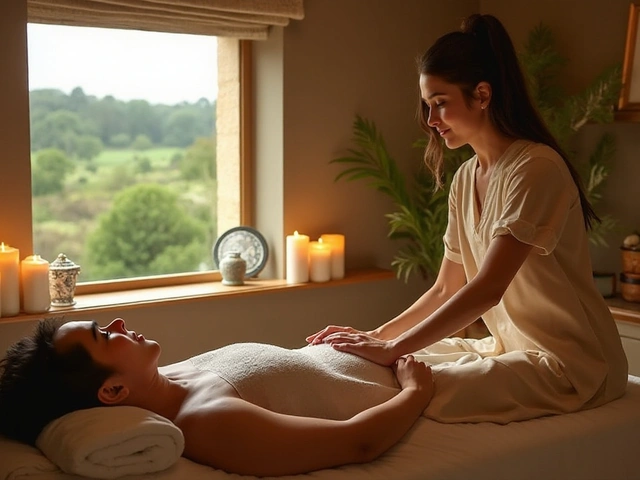Enhance Your Wellness Journey with Cupping Therapy

Today's wellness routines are increasingly embracing age-old practices, and cupping therapy is one of those gems making a comeback. This ancient technique offers a range of benefits that can elevate both physical and mental health. It’s becoming particularly popular as people seek more natural and holistic approaches to well-being.
Cupping therapy involves placing cups on the skin to create a suction effect. It's believed to enhance blood flow, relieve muscle tension, and promote healing. Let’s dive deeper into what this fascinating practice is, its potential benefits, and how you can integrate it into your wellness journey.
Understanding Cupping Therapy
Cupping therapy is a fascinating and ancient practice that dates back thousands of years. Its origins can be traced to both Egyptian and Chinese cultures, where it was used to treat a variety of ailments. In ancient Egypt, one of the earliest records of cupping therapy can be found in the Ebers Papyrus, a medical text that dates back to 1550 BC. This historical context adds a layer of depth to an already intriguing practice.
The technique involves placing cups on the skin and creating a suction effect to draw the skin and tissues up into the cup. Traditionally, these cups were made from materials like bamboo, clay, or glass. There are two main types of cupping therapy: dry cupping and wet cupping. Dry cupping uses the suction to increase blood flow and relieve muscle tension, while wet cupping involves small incisions on the skin to draw out a small amount of blood along with the suction. Wet cupping is less common in modern practice but still holds historical significance.
Modern practitioners often use silicone or plastic cups, which can be easier to handle and more hygienic. The suction can be created either by heating the air inside the cup (fire cupping) or using a manual or mechanical pump. Regardless of the type, the primary goal is to enhance circulation, alleviate pain, and promote healing. Increasingly, athletes incorporate cupping therapy into their recovery routines to speed up healing of sports injuries.
Though cupping therapy has gained popularity in recent years, partly thanks to high-profile endorsements from celebrities and athletes, its principles remain rooted in traditional medicine. Chinese medicine, for instance, believes that cupping helps to balance the flow of energy or “Qi” and remove any blockages in the meridians that run through the body. The idea is that by improving the flow of Qi, the body's natural healing processes are enhanced.
A 2015 review in the Journal of Traditional and Complementary Medicine noted that cupping could be beneficial for a range of conditions including chronic pain, migraines, and even digestive issues.
“Cupping therapy is an ancient treatment method that still offers significant benefits for various health conditions,” says Dr. Amy Chavez, a noted practitioner of traditional medicine.This speaks volumes about the enduring appeal and effectiveness of cupping therapy.
Critics often question the scientific evidence behind cupping, but several studies have shown positive results. For example, a study published in PLoS One in 2017 found that participants who underwent cupping therapy experienced a notable reduction in neck and shoulder pain. Another similar study demonstrated that cupping could reduce symptoms of carpal tunnel syndrome and back pain. These findings lend credibility to this age-old practice and suggest a need for further exploration.

Health Benefits
Cupping therapy has been practiced for thousands of years across various cultures, from ancient China to the Middle East. It is widely acknowledged for its numerous health benefits. One of the most prominent advantages is its ability to enhance blood circulation. By creating suction on the skin, cupping therapy increases blood flow to the cupped areas, which promotes healing and alleviates muscle tension.
Another significant benefit is its powerful, almost magical, pain relief. People dealing with chronic pain conditions, such as fibromyalgia or arthritis, find cupping therapy particularly useful. The suction action triggers muscle relaxation, reduces stiffness, and decreases overall pain levels. Many use it as a natural and effective alternative to pain medications.
Reducing inflammation is another key benefit of cupping therapy. When blood flow improves, your body’s natural mechanisms to fight off infections and reduce inflammation get a boost. This makes cupping particularly beneficial for those with inflammatory conditions such as asthma or certain skin diseases.
Cupping therapy is also praised for its stress-relieving properties. Today’s fast-paced lifestyle often comes with high levels of stress and anxiety, which can take a toll on our health. By alleviating muscle tension and improving blood flow, cupping promotes a calm, relaxed state of mind. Many individuals report feeling much more at ease after a session. According to a
study published in the Journal of Traditional Chinese Medicine, 89% of participants reported decreased stress levels after consistent cupping sessions.
Moreover, cupping can provide a beauty boost. By enhancing blood circulation and detoxifying the skin, it promotes a healthy glow. It's known to help with skin conditions like acne and eczema. This beauty benefit makes it a popular addition to holistic skincare routines.
The immune system also gets a tremendous boost from regular cupping therapy. By stimulating the flow of lymph, it helps in expelling toxins and pathogens out of the body. This natural detox process strengthens the immune system, making you less prone to getting sick. According to experts, adding cupping to your regular health routine can fortify your body's defenses.
Lastly, cupping therapy improves digestion. It helps in regulating digestive issues by promoting the movement of blood and fluids through the digestive organs. This can be particularly helpful for those dealing with conditions like Irritable Bowel Syndrome (IBS) or constipation.
The multitude of benefits offered by this ancient practice makes it a valuable addition to your wellness toolkit. Whether you’re looking to alleviate chronic pain, reduce stress, or simply enhance your overall health, cupping therapy offers a natural and effective solution. Always remember to seek advice from a professional before starting any new health practice to ensure it's suitable for you.

Different Methods
Cupping therapy may seem straightforward, but it actually comes in various forms, each with its own unique benefits and techniques. One of the most common methods is dry cupping. Here, cups are placed on the skin and left for a specific period. This method creates a vacuum that draws the skin into the cup, enhancing blood flow and promoting healing.
Wet cupping, also known as Hijama, involves making small incisions on the skin before applying the cups. The suction then draws out a small amount of blood. This technique is believed to remove toxins from the body and has roots in traditional medicine practices from the Middle East and Asia.
Fire cupping is another fascinating method where a flame is used to heat the air inside a glass cup. When the flame goes out, the cup is quickly placed on the skin. As the air in the cup cools, it creates a vacuum effect that draws the skin up. This method is particularly effective for muscle relaxation and pain relief.
Modern techniques have even introduced silicone cupping. These cups are flexible and can be moved across the skin for a massage-like effect. This form of cupping is often used on the back and shoulders to relieve muscle tension.
According to a 2012 study published in PLoS One, cupping therapy can be beneficial for treating chronic pain conditions like migraines and lower back pain. In this study, participants who underwent cupping experienced significant pain relief compared to those who didn’t.
"Cupping therapy, when applied correctly, can offer substantial benefits for chronic pain management by reducing inflammation and improving blood circulation," said Dr. Bruce Bentley, a leading expert in traditional medicine.
If you're considering incorporating cupping into your routine, it's essential to consult with a qualified practitioner. They can guide you on the appropriate method and frequency based on your specific needs. Each technique has its own set of benefits, and a professional can help you decide which one will work best for you.

Tips for Practicing Cupping
Cupping therapy is becoming a go-to method for those seeking natural remedies to improve their health. Whether you're a seasoned wellness enthusiast or a beginner curious about trying alternative treatments, here are some tips for practicing cupping that can help you get the most out of this ancient therapy.
First, it’s crucial to consult with a trained and certified therapist when you're just starting out. Cupping involves creating a vacuum effect on the skin, which can be intense if not done correctly. A professional will ensure the procedure is safe, hygienic, and effective. Many practitioners have specific areas of expertise and can offer personalized advice based on your health needs.
Once you’re comfortable with a professional session or two, you might consider doing it at home. Make sure to invest in good quality cups. There are various types, including glass, silicone, and plastic. Glass cups are often used in traditional fire cupping, which involves igniting a small flame to create the suction. Silicone and plastic cups, on the other hand, are easier to use for beginners and are often employed in more modern, vacuum-based techniques.
Before starting a session, thoroughly clean the skin to prevent any infections. Apply a small amount of oil or lotion to your skin to help the cups glide easily. This also makes removal smoother and less painful. Practice on a small area first to gauge how your body responds.
It’s also essential to be aware of how long to leave the cups on your skin. For beginners, it’s recommended not to exceed 5-10 minutes. Experienced users may go up to 20 minutes, but avoid overdoing it as it can lead to skin irritation or bruising. Always listen to your body and remove the cups if you feel any discomfort.
"Cupping therapy has shown promising results in reducing pain and increasing blood flow, making it a valuable tool in holistic health," says Dr. John Hopkins, a notable alternative medicine practitioner.
After your session, drink plenty of water to help flush out the toxins released during the therapy. Mild stretching and gentle massaging of the treated area can also enhance the benefits. You might notice reddening, circular marks on your skin – this is normal and typically fades within a few days.
Cupping therapy can be a great addition to other wellness practices such as acupuncture or chiropractic care. Combining these therapies can provide a comprehensive approach to pain management and overall health improvement. Don't hesitate to experiment with different cup sizes and durations to find what works best for you, but always keep safety and hygiene at the forefront.
Lastly, keep a journal of your cupping sessions. Note how you feel before and after each one, and any observations on how it affects your overall well-being. This practice can help you track your progress and optimize your therapy routine.





